The role of deformations and orientations in an alpha ternary fission of Thorium
2022-07-26MaheshBabuSowmyaManjunathaDhananjaya
A. V. Mahesh Babu • N. Sowmya• H. C. Manjunatha• N. Dhananjaya
Abstract The alpha ternary fission half-lives of thorium isotopes have been studied using the Coulomb and proximity potential models.The role of the deformation effects and the angle of orientation were included during the evaluation of the total potential. Fragment combinations were identified using cold valley plots of the driving potential. The half-lives and yields were evaluated using the penetration probability. The dependence of the logarithmic half-lives on different angles of orientation was studied. The evaluated alpha ternary fission yield was compared with that of the available experiments with and without deformations. The half-lives obtained in the present work were compared with those of the available data.Possible alpha ternary fission fragments were identified in the isotopes of thorium.The alpha ternary fission half-lives were compared to the binary fission half-lives. The binary fission half-lives are dominant in the 209-225Th nuclei, and the ternary fission half-lives are dominant in the isotopes of the 226-238Th nuclei.
Keywords Alpha ternary fission ∙Yield ∙Half-lives ∙Driving potential
1 Introduction
The splitting of heavy and superheavy nuclei into three fission fragments is referred to as ternary fission (TF). The long-range alpha particle experimentally observed by San Tsiang et al. [1] and later by Tsien et al. [2] discovered ternary fission. Manjunatha et al. [3] theoretically investigated ternary fission, binary fission, cluster, and alpha radioactivity in superheavy nuclei Z=126. Light-charged ternary fission has been studied experimentally [4–7] and theoretically [8–10]. Raisbeck [11] measured the angular distribution and energy spectrum of light particles that were accompanied by ternary fission of252Cf and showed maximum relative probability when the angular distribution was at θ=90°. Balasubramaniam et al. [12] studied the ternary fission of252Cf using a level-density approach by keeping48Ca as a fixed third particle using a threecluster model [13], alpha ternary fission in252Cf.
Triple correlation has been observed in ternary fission[14]. Probable alpha ternary fission fragments of257Fm have been studied [15]. In addition to ternary fission, binary, cluster, and alpha radioactivity has been studied in superheavy nuclei Z =122, 124, and 126 [3, 16, 17]. Ref.[6] observed enhancement of neutron intensity along the direction of alpha ternary particles when compared to the same in the opposite direction. Furthermore, Ref. [18]measured correlated alpha-particle energies and neutron velocities from252Cf at the relative angles 0°and 180°. In addition, many theoretical studies have focused on binary fission, cluster radioactivity, heavy-particle radioactivity,and alpha decay [19–22].
The lifetimes of234U and230Th[23]were studied using high-precision thermal ionization mass spectrometry(TIMS). Ha¨usser et al. [24] measured the lifetimes and αdecay energies of isotopes of thorium(218-220Th)using the recoil technique.Yahya and Falaye[25]evaluated α-decay half-lives of Thorium isotopes using the double folding potential model. Pahlavani and Karamzadeh [26] studied the partial α-decay half-lives of the thorium family.Ghorbani et al. [27] studied the temperature-dependent alpha-decay halves of isotopes of thorium. In the case of cold fusion reactions, isotopes of thorium are used as targets [28, 29]. Many studies [31–35] have shown the possible decay modes of superheavy nuclei by investigating binary fission,alpha ternary fission,spontaneous fission,αdecay, and cluster decay. All of these studies revealed a lack of information on the deformation parameter and angle of orientation in the isotopes of thorium nuclei. This has motivated us to investigate possible alpha ternary fission half-lives in209-239Th and to compare the alpha ternary fission half-lives with the binary fission half-lives.
The structure of the paper is as follows: the theory of evaluation of half-lives and yield by the inclusion of the deformation parameter and angle of orientation in the Coulomb and proximity potential model are presented in Sect. 2. The results and discussion of the present work are presented in Sect.3.The conclusions are presented in Sect.4.
2 Theory
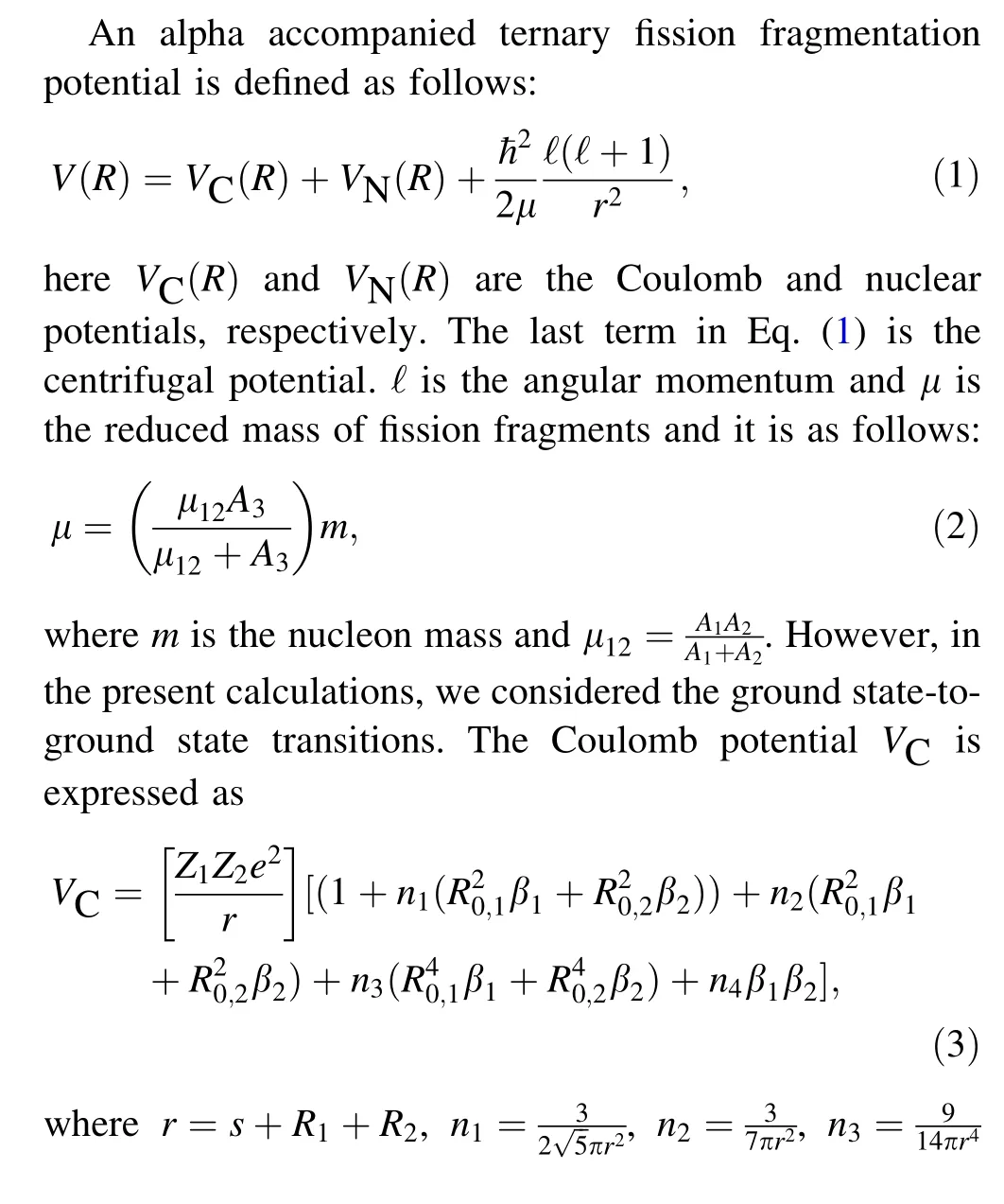

Here ξ=(r-C1-C2)/b and the width parameter b ≈1.The different values of αnconstant are α0=-0∙1886,α1=0∙2628, α2=-0∙15216, α3=-0∙04562, α4=0∙069136 and α5=-0∙011454.

3 Results and discussion
The total potential V(R) is evaluated for each fragmentation from the isotopes of thorium by with and without deformation the deformation parameter.Figure 1 shows the variation of an alpha accompanied by fragmentation potential as a function of the orientation degrees of freedom (θ). The figure clearly shows the dependence of the total potential on the angle of orientation. As the angle of orientation increased, there was a gradual increase in the total potential,and the maximum value of the potential was observed when θ=90°, that is, for the equatorial configuration. Later, it gradually decreased with an increase in the orientation angle. The maximum value of the total potential plays a key role in the evaluation of the half-lives.The greater the value of the total potential, the lower the half-life. Hence, to predict the smaller half-lives in the alpha accompanied by ternary fission, we considered the equatorial configuration, that is, θ=90°.

Fig. 1 Variation of total alpha accompanied fragmentation potential as a function of orientation degrees of freedom (θ)
The driving potential is the difference between total potential and amount of energy released during alpha ternary fission (i.e.,(V-Q)). The amount of energy released during an alpha ternary fission (i.e., keeping A3=4He as constant) and the mass excess values of parent and fission fragment combinations have been calculated from the latest mass excess table [30].
The role of deformations β2and orientation degrees of freedom were considered during the evaluation of alpha ternary fission. Figure 2 shows a plot of the driving potential with respect to the mass number of fission fragments A1with β2and without β2deformation in the equatorial configuration. The driving potential increases with an increase in the mass number of fission fragments,A1.The figure represents cold valley minima which occurs
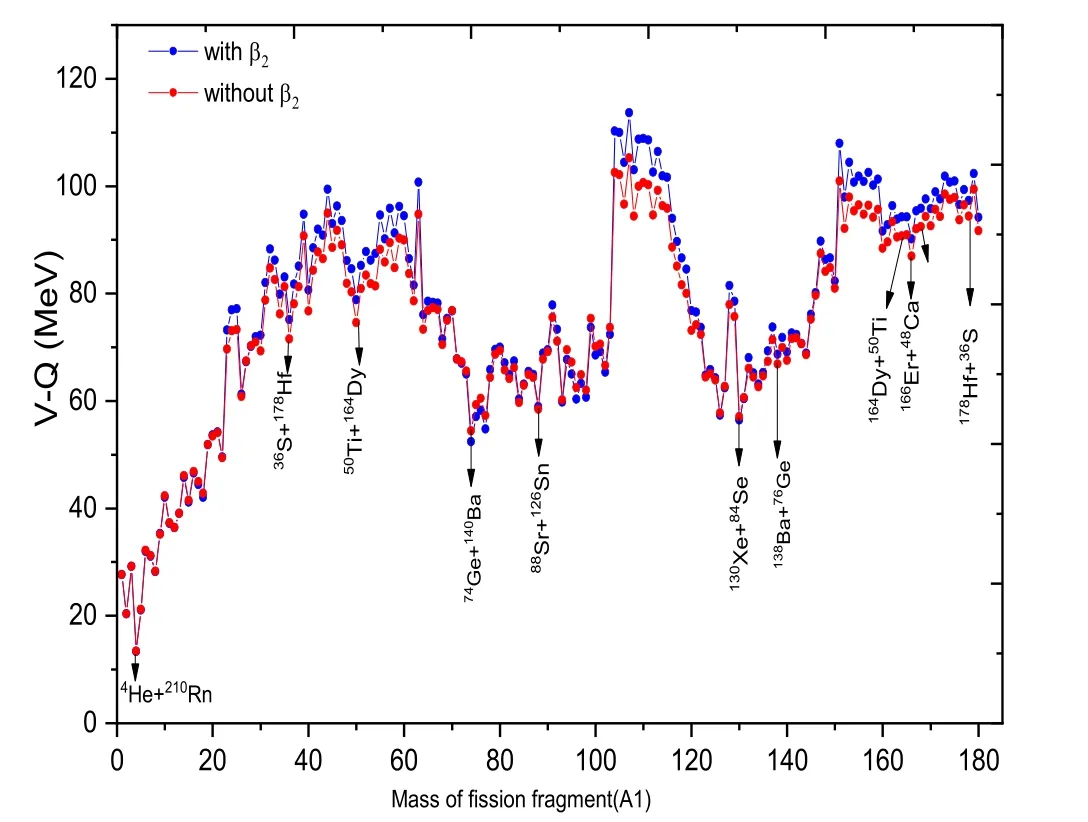
Fig.2 Plot of driving potential with respect to mass number of fission fragment A1 with β2 and without β2 deformation from the 218Th at θ=90°.

Further,the penetration probability is evaluated for each ternary fission fragment combinations using WKB integral method. The half-lives of an alpha-accompanied ternary fission fragment were evaluated, as explained in Eq. (13)(Fig. 3).
Furthermore, the role of the angle of orientation of fission fragments on the half-lives was studied. For example,an alpha ternary fission fragment of218Th was studied as a function of theta during the evaluation of the total potential. Because a shorter driving potential is observed in the case of88Sr+126Sn fission fragment combination from the parent nuclei218Th,the same fission fragment combination is used to evaluate the angle-dependent half-lives.The plot of logarithmic half-lives as a function of orientation angle,the logarithmic half-lives increase with an increase in the orientation angle, and a larger log T1/2is observed when θ=90°. Again, it gradually decreased with an increase in θ. Even though larger half-lives were observed when θ=90°, when compared to their neighboring fission fragment combinations,the value corresponding to θ=90°was shorter. Hence, in further analysis, we considered θ=90°for the evaluation of the half-lives and yield.
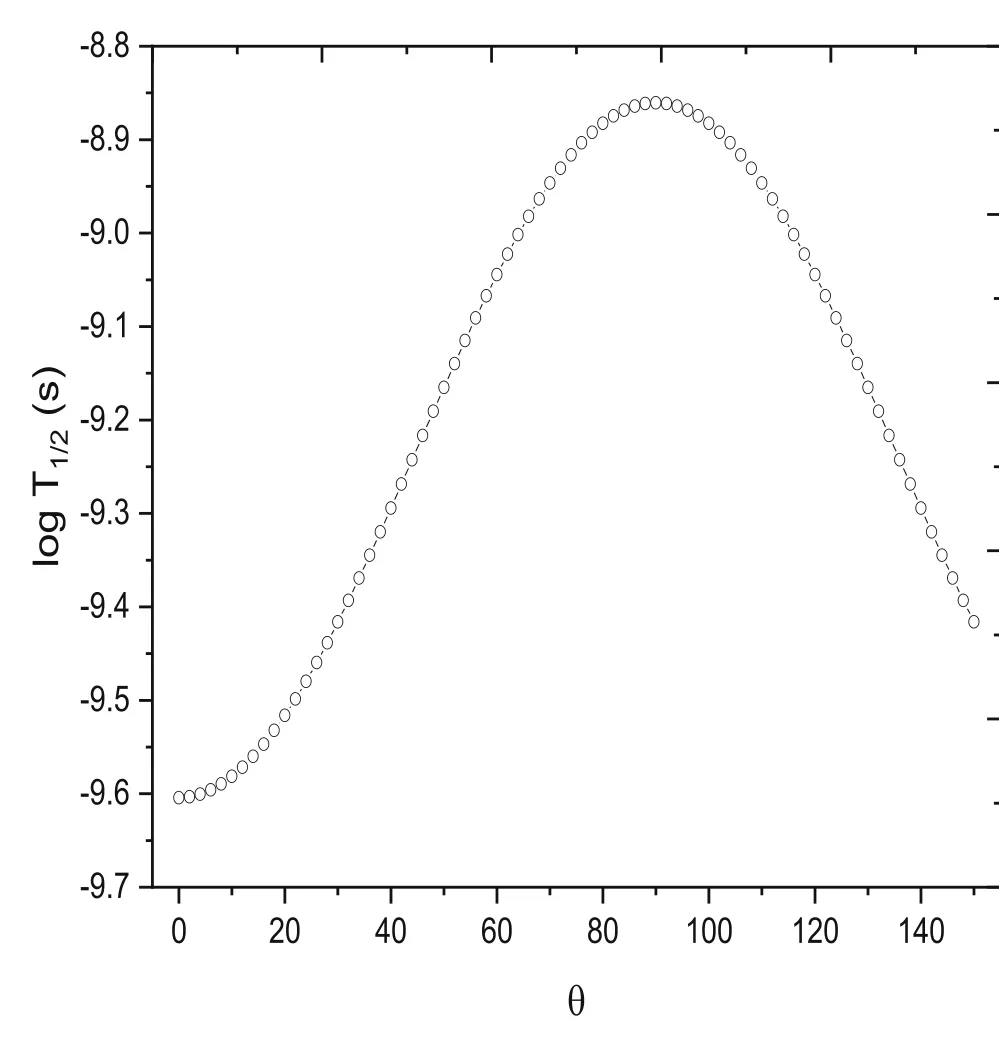
Fig. 3 A plot of logarithmic half-lives as a function of θ for the fission fragment combination 88Sr+126Sn+4He from 218Th
Figure 4 shows the variation in the logarithmic half-lives of alpha ternary fission with the mass number of fission fragments, A1. Shorter half-lives were observed for fission fragment combinations such as4He+210Rn,36S+178Hf,50Ti+164Dy,74Ge+140Ba,88Sr+126Sn,130Xe+84Se,138Ba+76Ge,164Dy+50Ti,166Er+48Ca, and178Hf+36S when compared to their neighbouring fission fragment combinations with the fission fragments, and the effect of deformations was also included. Among all the mentioned fission fragments with shorter half-lives,it was noticed that either of the fission fragment combinations possesses spherical nuclei, as seen in Fig. 4.The only exception was the fission fragment combination of130Xe+84Se which possess both oblate and prolate combinations.
The relative yield is evaluated as the ratio of the penetration probability of a given alpha ternary fission fragment to the sum of the penetration probabilities of all possible fission fragments,as in Eq.(5).The evaluated yield for the alpha ternary fission of218Th as a function of the mass number A1is shown in Fig.5.From the comparison shown in Figs.4 and 5,it shows that each shorter logarithmic halflive is comparable to a maximum value of relative yield.The maximum value of the relative yield is due to the presence of shell closure in fission fragment combinations of74Ge+140Ba,88Sr+126Sn,130Xe+84Se,and138Ba+76Ge,where the maximum peak is due to the presence of even nearly closed shells of140Ba (Z =56, N =84). Similarly,the larger peak was attributed to magic nuclei with Z =50 and N =50 for126Sn and84Se, respectively. Furthermore,138Ba (Z =56, N =82) was attributed to maximum yield due to the presence of magic nuclei.

Fig. 4 Plot of log T1/2 with respect to a mass number of fission fragment A1 with β2 and without β2 deformation from 218Th at θ=900

Fig. 5 Variation of yield with respect to mass number of fission fragment A1 from the parent nuclei 218Th at θ=90°
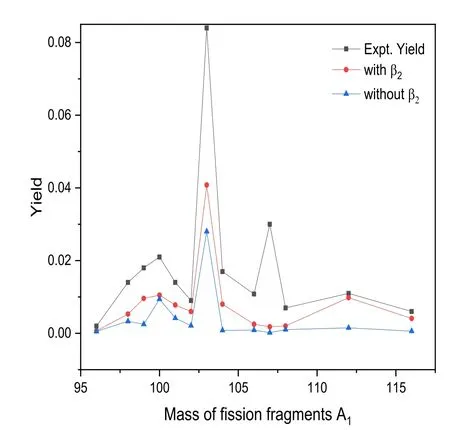
Fig.6 Comparison of ternary fission yields of 242Cf calculated using present work with that of experiments [15] for excluding and including deformations
Because there are no experimental data available for αternary fission of thorium,to validate the present work,we have reproduced the α-ternary fission yield of252Cf for which the experimental data are available [15]. The figure shows the prediction of alpha ternary fission fragments of252Cf with and without deformations, along with the experimental values available in the literature [15], as shown in Fig.6.From this comparison,it is noticed that the relative yield obtained by including the deformation effects is in close agreement with the available experiments when compared to that without the inclusion of the deformation parameter. After a detailed literature survey, it was found that there were no experimental α ternary fission half-lives.The only way to validate the evaluated α ternary fission half-lives is to compare them with the available theory.Poenaru et al. [37] evaluated the10Be ternary fission of a few heavy and superheavy nuclei within a three-center phenomenological model. Thus, to validate the present work, we also evaluated the10Be ternary fission half-lives and compared them with those of the Poenaru et al. [37]data. Table 1 shows a comparison between the present study and the available data. A close examination reveals that the values obtained in the present work are in good agreement with those of Poenaru et al. [37].
From a detailed study,it is observed that both the angle of orientation and the effect of deformations during theevaluation of half-lives and relative yield are in good agreement with those of the available experiments. Hence,by including both, we predicted the alpha ternary fission half-lives in the isotopes of209Th to238Th nuclei.Similarly, the binary fission fragments and their half-lives were identified by following the same methodology as in the case of alpha ternary fission. Figure 7 shows a comparison between ternary fission and binary fission halflives. From a detailed analysis, it is found that the binary fission half-lives are smaller in the209-225Th nuclei, and the ternary fission half-lives are smaller in the isotopes of226-238Th.

Table 1 Comparison of 10Be ternary fission fragment from the present work with that of Poenaru et al. [37]

Fig. 7 A comparison of binary and ternary fission half-lives of 209-338Th
Once the dominant decay mode has been identified in the isotopes of thorium,a plot of alpha ternary fission halflives versus the mass number of parent nuclei, along with the specification of the deformation parameter within the bracket, is shown in Fig. 8. As can be seen in Fig. 8a a small variation in the deformations from oblate to prolate(i.e., an increase in deformation from negative to positive)will result in the increase of binary fission half-lives in the isotopes of209-225Th.Similarly,an increase in the value of deformation from 0.173 to 0.224 increases the ternary fission half-lives of the isotopes of Th nuclei from226Th to238Th.From the detailed analysis,it is observed that a small change in the value of the deformation results in an observed change in the value of half-lives.
Finally, the role of deformations on the half-lives of209-238Th was studied, as shown in Fig. 9. However, no systematic variation is observed for negative quadrupole deformations in the case of binary fission (Fig. 9a).However,a close look at the half-lives shows a decrease in the logarithmic half-lives with an increase in the negative quadrupole deformations. Furthermore, an increase in the logarithmic half-lives of binary fission was observed for positive quadrupole deformations. In the case of α-ternary fission Fig. 9b, an increase in log T1/2is observed with an increase in positive quadrupole deformations. Hence, from the detailed analysis, it is clear that both quadrupole deformations and the angle of orientation influence the logarithmic half-lives.
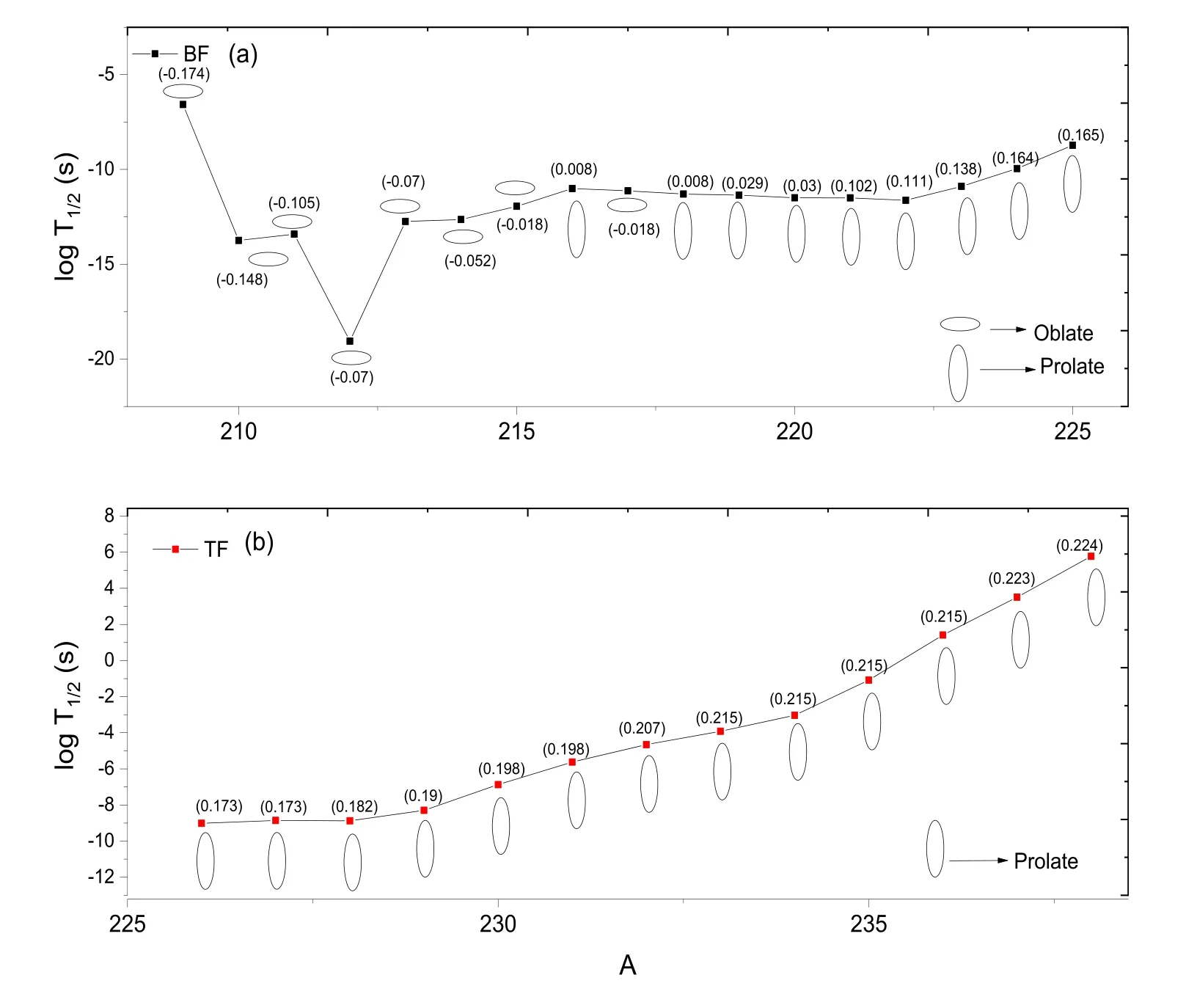
Fig. 8 Variation of alpha ternary fission half-lives versus mass number of parent nuclei along with the specification of deformation parameter

Fig. 9 Variation of a binary fission half-lives and b alpha ternary fission half-lives as function of deformation parameter of 209-338Th nuclei
4 Conclusion
The alpha ternary fission half-lives in the isotopes of thorium were studied using Coulomb and proximity potentials. The role of the angle of orientation and deformation effects was included in the evaluation of the total potential. The penetration probability of alpha ternary fission half-lives was evaluated using the Wentzel–Kramers–Brillouin(WKB)integral.Larger logarithmic half-lives are observed when θ=90°. The evaluated alpha ternary fission yield was compared with that of available experiments.The evaluated yields with deformation were in close agreement with those of the experiments compared to those without deformations. Based on the remarkable agreement of theoretical yield with that of available experiments, the study has been extended to the isotopes of thorium, and possible fission fragment combinations with shorter halflives have been identified. The half-lives evaluated using the present work were compared with those reported by Poenaru et al. [Acta Physica Hungarica Series A, Heavy Ion Physics 14(1),285– 295(2001)] Theoretical data. The binary fission half-lives are dominant in209-225Th nuclei,and the ternary fission half-lives are dominant in the isotopes of226-238Th nuclei. Hence, the behavior of fission half-lives under the influence of deformation and angle of orientation can help predict half-lives in future experiments.
杂志排行
Nuclear Science and Techniques的其它文章
- Feedforward compensation of the insertion devices effects in the SSRF storage ring
- A new radar stealth design excited by 210Po and 242Cm
- Development of an ultrafast detector and demonstration of its oscillographic application
- Low-radioactivity ultrasonic hydrophone used in positioning system for Jiangmen Underground Neutrino Observatory
- Study on analytical noise propagation in convolutional neural network methods used in computed tomography imaging
- Monte Carlo simulation of neutron sensitivity of microfission chamber in neutron flux measurement
